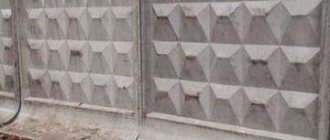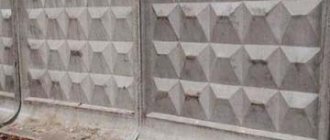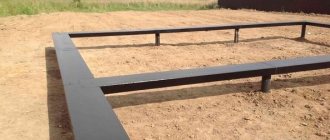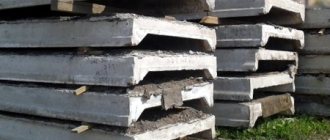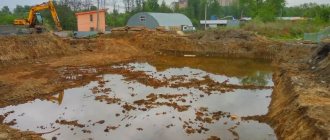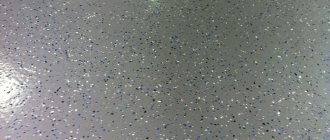Cement-based fencing elements are made of M200-300 concrete of strength class B15, 20 with frost resistance F50-100, which is reinforced with metal mesh and lasts for at least 50 years. Requirements for fence sections made of concrete panels are contained in many standards, including construction series 3.017-1, where the thickness of the slabs is standardized within the range of 8-16 cm, height - from 1.2 to 2.9 m. Installation is allowed on dry, hard ground.
On the left is a decorative fence, on the right is an industrial fence made of panels.
Advantages and disadvantages of concrete fences
Such fences are made from heavy concrete and steel reinforcement. This makes the fence resistant to temperature changes, stretching and compressive loads. Such a structure does not require a solid foundation, like brick fences. In addition, concrete slabs:
- protect the territory from prying eyes;
- create reliable protection against intruders;
- withstand significant loads, including hurricane winds, mechanical shocks;
- quickly installed;
- fire resistant;
- undemanding in care;
- absorb noise;
- If desired, the concrete surface can be painted.
According to the new SNiP for the planning and development of gardening associations, the fence between sections should be lattice or mesh and no higher than 1.5 m. Some models of concrete fences meet these requirements.
But there are also disadvantages. So, to install heavy slabs you need special lifting equipment or at least a team of strong assistants.
Depending on the design, there are several types of fences:
- Monolithic. These are massive slabs, the installation of which requires trucks.
- Typesetting walls. They are sections that consist of several plates connected to each other. The lower part of each element is solid, the upper part has a through pattern. Each panel weighs 50–70 kg.
Depending on the installation method, there are several types of concrete fences - on glass, free-standing, Euro fences.
Types and characteristics
Fence slabs are available in different sizes, weights, and with certain characteristics. The slabs differ mainly in dimensions, weight, external characteristics, installation method, and design features.
Main types of reinforced concrete fence slabs:
- Eurofences
– the weight of such panels is reduced, installation can be carried out without the use of special equipment. Usually these are fences with a decorative pattern on the outside, reinforced with rolled metal on the inside. Standard Europanel size: length 200 centimeters, height 50 centimeters, weight up to 90 kilograms. Such panels are universal: they look good, are available in different textures and shades, are of high quality and durable, easy to install (they can be fixed in support pillars with special grooves or threaded into one another). These slabs are most often chosen for fencing private areas.
- Block panels
- such a fence is assembled in the same way as a brick fence. The blocks can be reinforced or hollow, are available in a variety of colors, and can have a decorative coating.
- Tile products
– concrete slabs of standard sizes with specific markings. The most common version of a conventional reinforced concrete fence. The slabs are presented in a large number of standard sizes, as reflected by their markings.
So, for example, the marking of the 2PB 30-16 plate indicates that the dimensions of the product are as follows: length 298 centimeters (almost 30 decimeters), height 160 centimeters (16 decimeters), width 12 centimeters.
Fences made of large slabs are used mainly for fencing closed facilities and industrial areas. The slabs can weigh a lot, so they are installed using special equipment.
In private households, lightweight and easy-to-install euroslabs are usually used. They are installed in special “glasses” or other elements, fixed efficiently and easily, and 2-4 people can install the entire fence. A low decorative fence can be made independently by one person.
The main components of any slab:
- Concrete grade M20 and higher.
- Reinforcement frame made of steel class A-3, VR-1.
- Standard sizes - indicated in the markings (usually as part of the name of the stove).
You can give an explanation of this marking: 1PB 40-20 GOST 13015.X - concrete slab of the first standard size (4000 millimeters by 2000 millimeters). The main documents regulating the production of slabs: GOSTs 13579-78, 12767-94, TU 67-07-232-89.
Self-standing fences
These are monolithic structures that do not require a foundation. At the bottom they have a profile in the form of an inverted letter T or G, which plays the role of a foundation.
The advantages of self-standing slabs include:
- minimal excavation work;
- the structure can be dismantled and reused;
- quick installation if lifting equipment is available.
Self-standing structures are especially in demand in areas with groundwater.
Usually, pouring a foundation there is expensive, since there is a need for reinforced reinforcement and deep planting of the foundation.
Such fences are only useful on level ground. And when you need to fence off an area located on a slope, use panels on glasses.
In addition, they cannot be installed on loose soil without compacting it, since the weight of one element reaches 2 tons.
Installation of a free-standing fence
Before starting work, study the location of power lines on the site in the area where the crane is supposed to be used.
Then you need to obtain a permit to carry out work from the company that owns the power transmission line, or from the responsible employee of the construction and installation organization, if he has such a right.
The installation itself is carried out in this order:
- Mark the territory.
- According to the markings, dig a trench with a width equal to the base of the slab plus 20 cm and a depth of 15 cm.
- Sand, crushed stone or rock screenings are poured into the recess in layers, compacted thoroughly.
- Plates are installed.
- Separate elements are fastened by welding on embedded parts.
A cushion under a slab of sand and crushed stone prevents the soil from becoming soggy during rains.
Reinforced concrete fencing slabs
A reinforced concrete fencing slab performs the function of an enclosing element in civil, industrial and other types of construction, where it is necessary to organize restriction of access to a certain territory. Installation is carried out in conjunction with glass-type foundations.
produces products from the category “reinforced concrete fencing panels”, shown in the table above. There you will also find links to a detailed description of each of them.
You can explore the rest of the range of concrete products by downloading our price list.
Application of concrete barriers
Reinforced concrete fencing slabs have become widespread due to a number of advantages, the main ones of which are the following four:
- Reliability. There is no need to talk separately about the strength of reinforced concrete; this is a generally accepted fact.
- Easy to install. The technology for installing slabs has been simplified to the point of impossibility. Each of them has special “legs” that are simply inserted into the prepared glass foundation.
- Saving. The construction of such a fence is much cheaper than, for example, brickwork.
- Aesthetics. For better resistance to wind loads, fence slabs are equipped with relief geometric patterns. This at the same time gives them an aesthetic appearance and allows them to fit into almost any area. Such fences look much more decent than wooden or metal mesh.
The scope of application of fencing panels can be very different. They are used both as temporary structures (concrete fencing of a construction site) and on a permanent basis (fencing the territory of an industrial enterprise). Reinforced concrete fences can perform several functions at once:
- Preventing people or large animals from entering the property
- Hiding from prying eyes any objects located on the territory.
- Soundproofing
- Landscaping
- Other additional functions (for example, a surface for placing advertising or some information)
The movement and installation of reinforced concrete fencing panels is carried out using special equipment. This is due to the large mass of the plates. The lightest fencing slab in our range of products weighs 1600 kg, the heaviest - more than two tons. In order for massive slabs to be securely fixed, they are installed in special glass foundations. The foundations have a large base surface, which allows the load from the weight of the slab to be evenly distributed onto the ground. In addition, they prevent the panels from tipping over.
Unlike a brick structure of a similar purpose, a reinforced concrete fencing slab does not require the installation of a foundation along its entire length. It is enough to install two “glasses” on both edges of the structure. After inserting the support pillars of the panel into the grooves of the foundations, the joints are sealed with concrete.
As we mentioned above, the weight of one panel can exceed two tons. The foundations for them are also quite massive; they can weigh from 480 to 750 kg. The reinforced concrete fencing slabs have the same dimensions in width (160 mm) and almost the same in height (about 2.5 m). The length can vary from three to four meters.
A summary table containing the dimensions, weight, concrete consumption and prices of all reinforced concrete fences and foundations for them can be studied here. The geometric parameters of products from this series are contained in Series 3.07-1
Prices for reinforced concrete fencing panels
The construction of a fence made of reinforced concrete products is approximately 30% cheaper than brickwork. And in terms of price/durability ratio, this material has no equal. For reinforced concrete fences, the price will depend mainly on the choice of standard size, as well as on the selection of the foundation.
If you conduct a simple analysis of prices for concrete products on the websites of supplier companies, you can very easily identify direct manufacturers among them. For the latter, the cost of products is cheaper by an average of 30-40%. StroyPromZhBI LLC is just such an organization.
Our plant is located near Tula. We supply reinforced concrete products, including reinforced concrete fencing slabs, both to neighboring regions (Moscow, Kaluga, Oryol, Lipetsk and others) and to remote regions of Russia. To clarify production and delivery conditions, please contact our sales office by calling the numbers in the site header or on the “Contacts” page.
Concrete slabs on glasses
Such fences are built from two parts:
- plate;
- a glass part that acts as a foundation.
The slabs in these designs can be with or without an apron. Sections of the first type are installed if the glasses remain on the ground. The second ones are for foundations immersed in the ground.
Such fences are installed in two ways:
- the glasses are buried in the ground, and then slabs are inserted into them;
- First, the base for the glasses is concreted, and only then the sections are fixed.
Sometimes companies offer to purchase used concrete fences, which can be approximately half the price of new ones. If you want to save money, then the structure needs to be inspected. Pay attention to whether the mounting loops by which the slabs are lifted are intact and whether there is any damage to the concrete elements.
How to buy reinforced concrete products for a fence?
You can buy reinforced concrete products for the fence by placing an order at the ZhBI-4 plant. Having agreed with the company manager on the modification and quantity of required panels and cups, you must pay the invoice and specify the date the order will be ready. Ordered panels can be delivered to the customer’s site by our vehicles.
The company's managers will answer all your questions regarding the execution and readiness of the order by phone. You can also get all the necessary information about our products and the conditions for their purchase through the online form.
Concrete eurofences
This is the name for stacked type fences, consisting of two components - concrete slabs and supports with grooves.
This is one of the most popular types of fences made from concrete, which are popular in individual households, gardens and summer cottages.
The advantage of such structures is that installation does not require special equipment.
Sergey
builder
The work can be completed by a team of 3-4 people. The fence does not need a foundation - you just need to concrete the support pillars.
— Sergey builder
Fence installation
Installation of the eurofence is carried out in the following order:
- The territory is marked in accordance with the dimensions of the structural elements.
- Dig a hole 70–80 cm in diameter, 20 cm wider in diameter than the side of the post.
- Insert the first post and fix it in the hole using broken bricks or crushed stone.
- Fill the hole with the solution.
- Install all supports.
- They wait for the concrete to set, but not less than a day.
- Insert the plates into the grooves.
In areas with difficult terrain, poles are installed in “steps”. Then it may be necessary to trim the panels or increase the length of the groove in the post. If you need to make a turn, then use two support pillars at once.
The method when supports are installed immediately has two disadvantages:
- you need to mark the area so that the slabs fit exactly into the side recesses on the supports;
- the sections will have to be lifted above the supports, and they are quite heavy.
The second method is considered more convenient. It looks like this:
- The first pillar is installed and concreted as described above.
- Plates are inserted on both sides.
- The second post is placed on the slab, and only after that is fixed in the ground.
- Continue installation according to the same scheme.
- Check the position of the slabs vertically and horizontally.
- Fill the holes with cement.
Mistakes made when installing a European fence
Often, after installation, the supporting part of the fence is destroyed.
This is due to the fact that the depth of the initial installation is not maintained, when some pillars are higher than others.
Another problem encountered due to improper installation technology is sections falling out. This happens if the posts are spaced too widely.
With a groove depth of 4 cm, the slab should fit into it at least 3 cm (or 75%). If this requirement is not met, the sections are damaged at the corners.
Sergey
builder
Usually, installation defects become noticeable after a year of fencing operation.
— Sergey builder
Imitation of strip foundation
1. Support block (angular)
- 300 Height, mm
- 220 Length, mm
- 210 Width, mm.
- 50 Groove, mm
- 25 Weight, kg
- RUB 700.00 Price on gray cement
2. Support block
- 300 Height, mm
- 240 Length, mm
- 180 Width, mm.
- 50 Groove, mm
- 22 Weight, kg
- RUB 700.00 Price on gray cement
3. Support block
- 300 Height, mm
- 240 Length, mm
- 180 Width, mm.
- 70 Hole diameter, mm
- 22 Weight, kg
- RUB 750.00 Price on gray cement
4. Reinforced concrete panel. brick texture
- 300 Height, mm
- 2500 Length, mm
- 45 Thickness, mm
- Single sided type
- 70 Weight, kg
- RUB 900.00 Price on gray cement
Caring for a concrete fence
As already mentioned, maintaining concrete fences is easy. One of the most important activities is timely cleaning of the fence. For this you will need:
- soap or special detergent for concrete surfaces;
- pure water;
- garden hose;
- sponge.
Soap is dissolved in water (the concentration depends on the degree of contamination of the slabs). If detergents are used, dilute them according to the instructions. Soak a sponge in the solution and wipe the surface of the panels, then rinse with clean water. It is convenient to use a garden hose for this.
If the concrete has not been treated with antiseptic impregnations, it may become covered with moss. Vegetation is cleared from the fence using a brush. It is most convenient to use construction material with metal pile.

